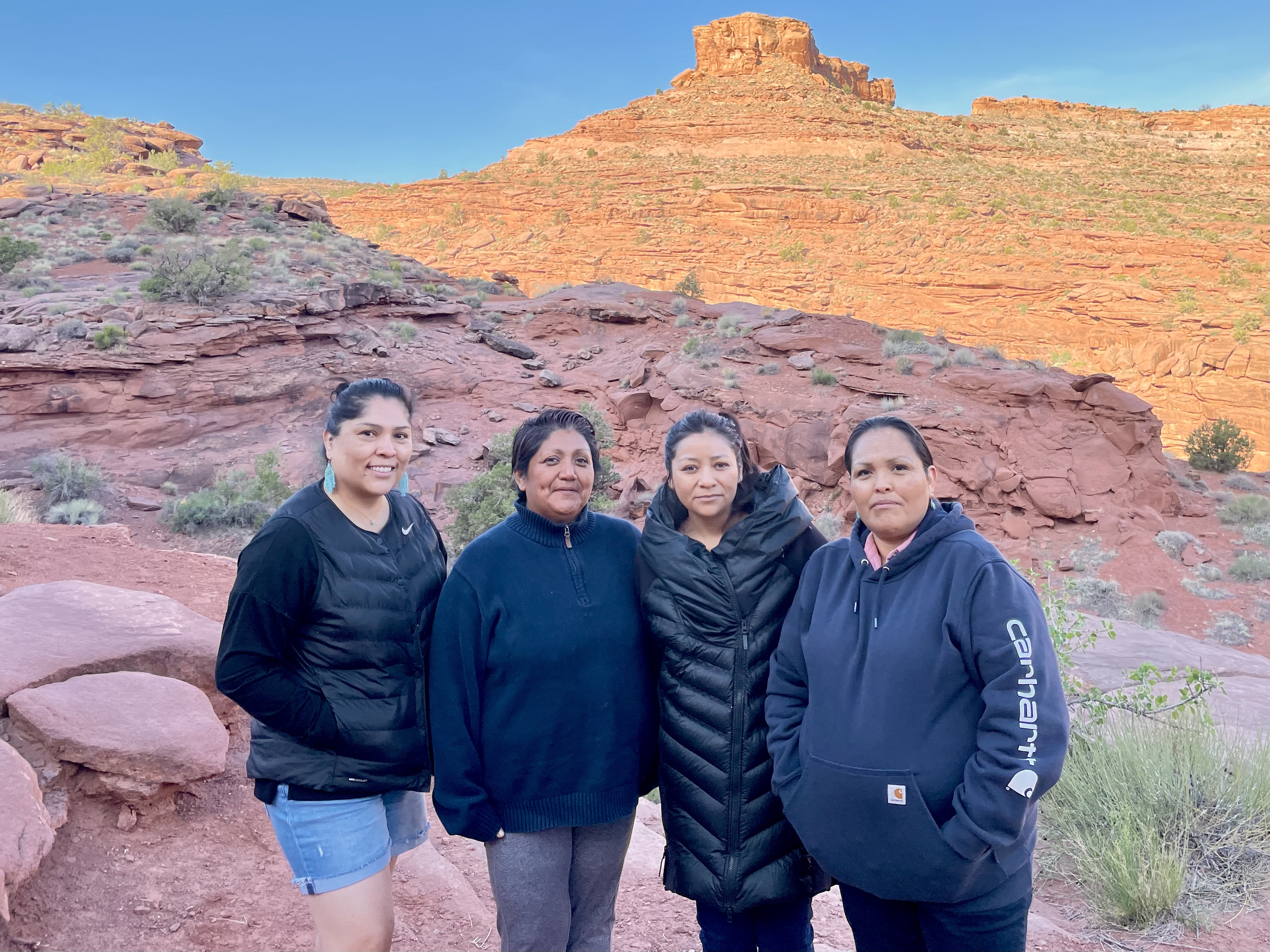On Mother’s Day, a prayer at the defaced Birthing Rock

From left: Davina Smith, Regina Lopez-Whiteskunk, Ahjani Yepa, and Tara Benally came to Birthing Rock from around the American Southwest on Sunday to pray over the defaced rock imagery. Photo by Carter Pape, licensed for exclusive use
Before sunrise on Sunday, May 9, four mothers and one of their daughters drove down Kane Creek in Moab to look for a recently defaced relic their ancestors created roughly 1,000 years ago.
The Mother’s Day trip to Birthing Rock came 13 days after the multi-panel petroglyph site was found desecrated, with the words “white power” and other profanities scrawled over the imagery — an artifact of pre-colonized Utah.
The four mothers making the trip — a kind of pilgrimage in search of healing — had never been to the site before. They came together through the group Women of Bears Ears, which supports the restoration of Bears Ears National Monument.
Each said she felt called to visit the rock that morning after learning of its defacement and to pray over it. They said it was a form of medicine.
But, before they could pray over the site, they first had to find it. Regina Lopez-Whiteskunk, the elder of the group and a member of the Ute Mountain Ute, said she was a bit confused when she parked to find the rock, amid a sea of other rocks.
Fortunately, her daughter had a sense for where to find it.
“My daughter says, ‘It’s right there mom,’” Lopez-Whiteskunk recalled. “I was like, ‘Gee, how did you see that?’ She goes, ‘It called out to me.’”
The women’s convergence marked their first communion since the start of the pandemic, Lopez-Whiteskunk said. It was a bittersweet reunion, though they emphasized the sweet. Lopez-Whiteskunk described hugging the women after they met up and declared to each other that they were vaccinated.
“Prior to this moment, throughout the past year, we haven’t been able to do that. We’ve been existing in a whole virtual world, and to be able to come up this road after we’ve hugged each other and we’ve laughed,” Lopez-Whiteskunk said, pausing. “No more bubble.”
She said that the trip was a “beautiful way to come together, but it’s no thanks to a senseless act.”
“But,” she continued, “that act happened for a reason, and thank you to whoever did that because it brought four beautiful women and my daughter — our daughters — with us to be here. Although it’s a negative behavior, it had a positive outcome.”
Ahjani Yepa is a member of the Pueblo of Jemez tribe. She also thanked the vandal for bringing the women together. Had the destructive act not taken place, she said, “I might not have felt that urgency to come here.”
“Now that we see the defacement with our own eyes, what really shows through is the resiliency that our ancestors had that exists within us,” Yepa said.
She said that the vandalism was “an attempt at erasure” that fits in with a tradition of “genocide” of Native Americans in the United States, but she said that the thing that “shows through stronger than that attempt at erasure is the image” underneath the graffiti.
As part of answering a question about what Birthing Rock meant to her, Tara Benally, who said she is of “Hopi descent, born from Navajo,” redirected the conversation to what the site means to non-Indigenous people.
“The conversation really needs to start from: What does it mean to you, as a non-Indigenous person?” Benally asked.
Davina Smith, who is Diné (Navajo), picked up the thread. She said that rock imagery from Native Americans is less a part of formal education and societal discussions than it ought to be.
“How often is that discussed in society today? Obviously, not much,” Smith said, pointing to the defaced petroglyph.
Lopez-Whiteskunk said that learning of the defacement hit her “like a ton of bricks.” She had been on a virtual call with the women, and she had to shut off her camera after hearing the news.
“I didn’t know what to expect or how I was going to be when I got here,” Lopez-Whiteskunk said.
Standing before the rock, she was reminded of the resilience of the people who created it. “That rock to someone else might look like evidence of a dead society, but it isn’t,” she said. “It’s very much alive.”
Lopez-Whiteskunk said on behalf of the women that being near Birthing Rock, one of many petroglyph sites in the region, “pummels us back to a sense of origin.”
“We also know the pain of that moment of impact of labor and bringing that child into this world,” Lopez-Whiteskunk said. “All the sacrifices we make from that day forward are going to be for our children and the next generations. That’s excruciating pain, but it’s burden of love.”
Raw: names
So I don’t forget.
- Davina Smith, Diné
- Regina Lopez-Whiteskunk, Ute Mountain Ute
- Ahjani Yepa, Jémez Pueblo
- Tara Benally, Hopi descent, born from Navajo